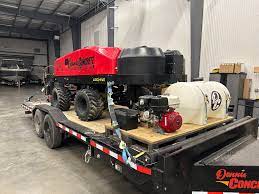Undertaking a concrete project demands careful consideration of various factors, with the choice of concrete equipment playing a pivotal role in project success. Whether you’re a seasoned contractor or a DIY enthusiast, selecting the right self-concrete equipment is crucial for maximizing efficiency and achieving the desired results. In this comprehensive guide, we’ll navigate through the key considerations to help you make informed decisions when choosing the appropriate concrete equipment for your project.
1. Understand Your Project Requirements:
Before delving into the world of concrete equipment, gain a clear understanding of your project’s specific requirements. Consider factors such as project scale, timeline, budget, and the type of concrete work involved. This foundational knowledge will guide you in choosing the most suitable equipment for your needs.
2. Concrete Mixer: Choosing the Right Type:
– Portable Electric Mixers:
Ideal for smaller projects and DIY enthusiasts, portable electric mixers are user-friendly and convenient. They are easy to transport and operate, making them suitable for tasks such as creating pathways, small slabs, or concrete patches.
– Towable Concrete Mixers:
For medium to large-scale projects, towable concrete mixers offer increased capacity and efficiency. These mixers can be attached to a vehicle for transportation, providing flexibility on job sites with varying concrete needs.
– Batching Plants:
Large construction projects may require the use of batching plants for high-volume concrete production. Batching plants automate the mixing process, ensuring consistent and precise concrete batches. They are ideal for projects like commercial buildings, bridges, or infrastructure developments.
3. Concrete Pump: Enhancing Placement Precision:
– Boom Concrete Pump:
Suitable for projects that require long-distance and high-rise concrete placement, a boom concrete pump utilizes a robotic arm to precisely place concrete. This equipment is advantageous for large construction sites where manual pouring may be challenging.
– Line Concrete Pump:
Line concrete pumps are versatile and commonly used for medium-sized projects. They are suitable for horizontal and vertical concrete pumping and offer flexibility in navigating obstacles on the job site.
4. Concrete Vibrator: Ensuring Consistent Compaction:
– Internal Vibrators:
Internal concrete vibrators are immersed directly into the concrete mixture to eliminate air voids and ensure proper compaction. They are suitable for projects like slabs, foundations, or columns and are available in various sizes for different applications.
– External Vibrators:
External concrete vibrators are attached to the formwork or surface of the concrete to facilitate compaction. They are commonly used for larger projects and can be maneuvered to cover expansive areas efficiently.
5. Concrete Saw: Tailored for Precision Cutting:
– Handheld Concrete Saws:
Handheld concrete saws are practical for smaller projects that require precision cutting. They are maneuverable and easy to use, making them suitable for tasks like creating expansion joints or shaping concrete blocks.
– Walk-Behind Concrete Saws:
Walk-behind concrete saws are suitable for larger projects where efficiency is crucial. They offer stability and can cover more extensive areas, making them ideal for tasks such as road construction or concrete slab cutting.
6. Concrete Trowel: Achieving a Polished Finish:
– Walk-Behind Power Trowels:
Walk-behind power trowels are efficient for finishing large concrete surfaces. They are motorized and equipped with multiple blades to create a smooth and polished finish. Ideal for projects like floors, driveways, or patios.
– Hand Trowels:
Hand trowels are suitable for smaller projects and intricate details. They provide control and precision for finishing edges, corners, and areas where power trowels may be challenging to maneuver.
7. Concrete Grinder: Smoothing and Leveling Surfaces:
– Handheld Concrete Grinders:
Handheld concrete grinders are versatile tools for smaller projects and spot grinding. They are effective in removing imperfections, adhesives, or coatings from surfaces.
– Walk-Behind Concrete Grinders:
Walk-behind concrete grinders are powerful machines designed for larger projects. They are suitable for leveling surfaces, removing high spots, and preparing concrete for coatings or overlays.
8. Concrete Screed: Ensuring Level Surfaces:
– Vibrating Truss Screeds:
Vibrating truss screeds are efficient for large-scale projects such as roads or pavements. They use vibration to level and consolidate concrete, ensuring a smooth and even surface.
– Handheld Straight Edge Screeds:
Handheld straight edge screeds are ideal for smaller projects and offer manual leveling control. They are practical for tasks like driveways, sidewalks, or garage floors.
9. Concrete Finish Broom: Adding Texture:
– Broom Finish Concrete Brooms:
Broom finish concrete brooms are essential for adding a non-slip texture to concrete surfaces. They are commonly used for outdoor projects like walkways, driveways, and pool decks.
10. Concrete Testing Equipment: Ensuring Quality:
– Compression Testing Machines:
Compression testing machines assess the compressive strength of concrete samples. They are vital for quality control, ensuring that the concrete meets specified standards.
– Concrete Moisture Meters:
Concrete moisture meters help measure the moisture content within concrete, a critical factor in preventing issues such as cracking or adhesion problems.
11. Safety Gear: Prioritizing Well-Being:
– Personal Protective Equipment (PPE):
Essential safety gear includes gloves,
Undertaking a concrete project demands careful consideration of various factors, with the choice of concrete equipment playing a pivotal role in project success. Whether you’re a seasoned contractor or a DIY enthusiast, selecting the right self-concrete equipment is crucial for maximizing efficiency and achieving the desired results. In this comprehensive guide, we’ll navigate through the key considerations to help you make informed decisions when choosing the appropriate concrete equipment for your project.
1. Understand Your Project Requirements:
Before delving into the world of concrete equipment, gain a clear understanding of your project’s specific requirements. Consider factors such as project scale, timeline, budget, and the type of concrete work involved. This foundational knowledge will guide you in choosing the most suitable equipment for your needs.
2. Concrete Mixer: Choosing the Right Type:
– Portable Electric Mixers:
Ideal for smaller projects and DIY enthusiasts, portable electric mixers are user-friendly and convenient. They are easy to transport and operate, making them suitable for tasks such as creating pathways, small slabs, or concrete patches.
– Towable Concrete Mixers:
For medium to large-scale projects, towable concrete mixers offer increased capacity and efficiency. These mixers can be attached to a vehicle for transportation, providing flexibility on job sites with varying concrete needs.
– Batching Plants:
Large construction projects may require the use of batching plants for high-volume concrete production. Batching plants automate the mixing process, ensuring consistent and precise concrete batches. They are ideal for projects like commercial buildings, bridges, or infrastructure developments.
3. Concrete Pump: Enhancing Placement Precision:
– Boom Concrete Pump:
Suitable for projects that require long-distance and high-rise concrete placement, a boom concrete pump utilizes a robotic arm to precisely place concrete. This equipment is advantageous for large construction sites where manual pouring may be challenging.
– Line Concrete Pump:
Line concrete pumps are versatile and commonly used for medium-sized projects. They are suitable for horizontal and vertical concrete pumping and offer flexibility in navigating obstacles on the job site.
4. Concrete Vibrator: Ensuring Consistent Compaction:
– Internal Vibrators:
Internal concrete vibrators are immersed directly into the concrete mixture to eliminate air voids and ensure proper compaction. They are suitable for projects like slabs, foundations, or columns and are available in various sizes for different applications.
– External Vibrators:
External concrete vibrators are attached to the formwork or surface of the concrete to facilitate compaction. They are commonly used for larger projects and can be maneuvered to cover expansive areas efficiently.
5. Concrete Saw: Tailored for Precision Cutting:
– Handheld Concrete Saws:
Handheld concrete saws are practical for smaller projects that require precision cutting. They are maneuverable and easy to use, making them suitable for tasks like creating expansion joints or shaping concrete blocks.
– Walk-Behind Concrete Saws:
Walk-behind concrete saws are suitable for larger projects where efficiency is crucial. They offer stability and can cover more extensive areas, making them ideal for tasks such as road construction or concrete slab cutting.
6. Concrete Trowel: Achieving a Polished Finish:
– Walk-Behind Power Trowels:
Walk-behind power trowels are efficient for finishing large concrete surfaces. They are motorized and equipped with multiple blades to create a smooth and polished finish. Ideal for projects like floors, driveways, or patios.
– Hand Trowels:
Hand trowels are suitable for smaller projects and intricate details. They provide control and precision for finishing edges, corners, and areas where power trowels may be challenging to maneuver.
7. Concrete Grinder: Smoothing and Leveling Surfaces:
– Handheld Concrete Grinders:
Handheld concrete grinders are versatile tools for smaller projects and spot grinding. They are effective in removing imperfections, adhesives, or coatings from surfaces.
– Walk-Behind Concrete Grinders:
Walk-behind concrete grinders are powerful machines designed for larger projects. They are suitable for leveling surfaces, removing high spots, and preparing concrete for coatings or overlays.
8. Concrete Screed: Ensuring Level Surfaces:
– Vibrating Truss Screeds:
Vibrating truss screeds are efficient for large-scale projects such as roads or pavements. They use vibration to level and consolidate concrete, ensuring a smooth and even surface.
– Handheld Straight Edge Screeds:
Handheld straight edge screeds are ideal for smaller projects and offer manual leveling control. They are practical for tasks like driveways, sidewalks, or garage floors.
9. Concrete Finish Broom: Adding Texture:
– Broom Finish Concrete Brooms:
Broom finish concrete brooms are essential for adding a non-slip texture to concrete surfaces. They are commonly used for outdoor projects like walkways, driveways, and pool decks.
10. Concrete Testing Equipment: Ensuring Quality:
– Compression Testing Machines:
Compression testing machines assess the compressive strength of concrete samples. They are vital for quality control, ensuring that the concrete meets specified standards.
– Concrete Moisture Meters:
Concrete moisture meters help measure the moisture content within concrete, a critical factor in preventing issues such as cracking or adhesion problems.
11. Safety Gear: Prioritizing Well-Being:
– Personal Protective Equipment (PPE):
Essential safety gear includes gloves,



